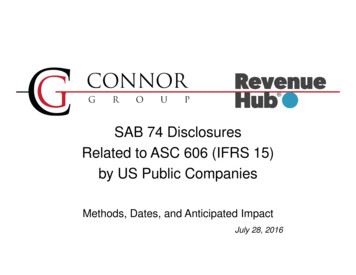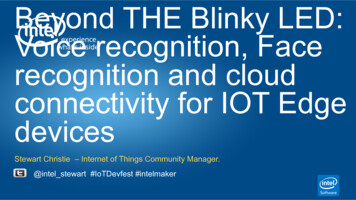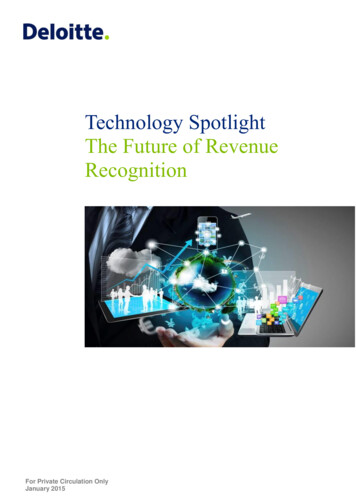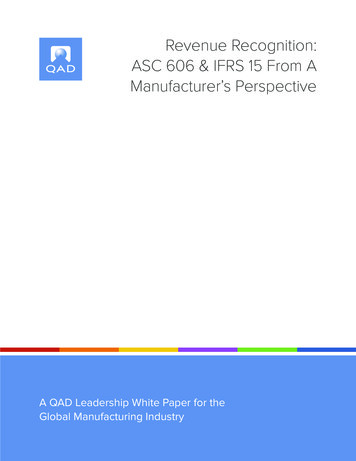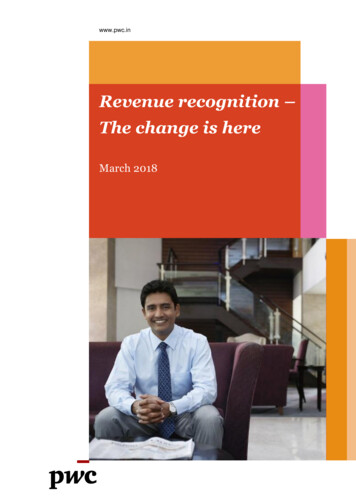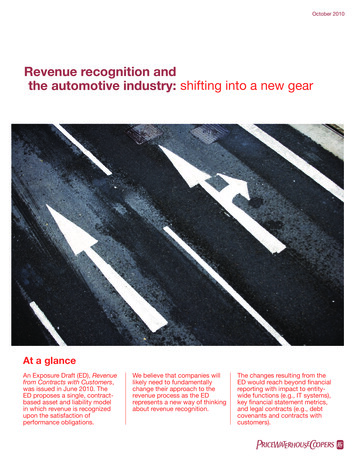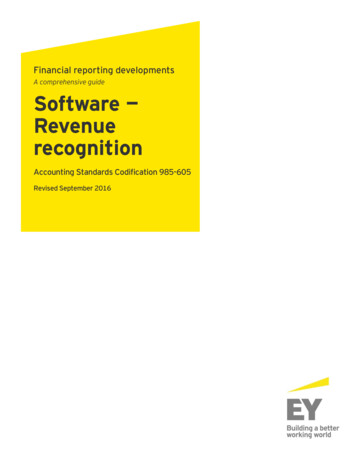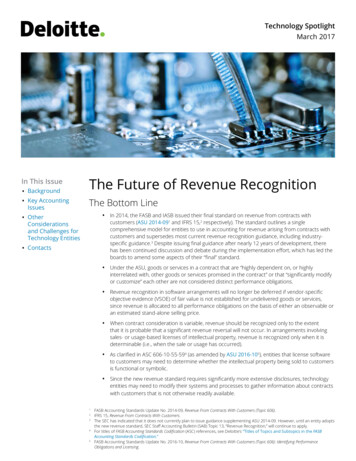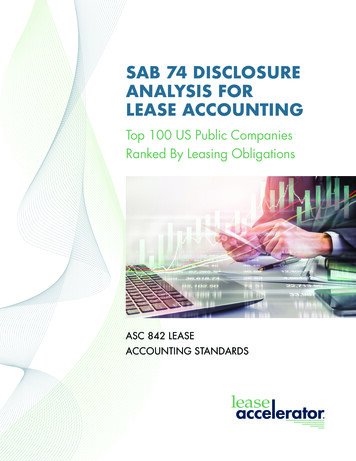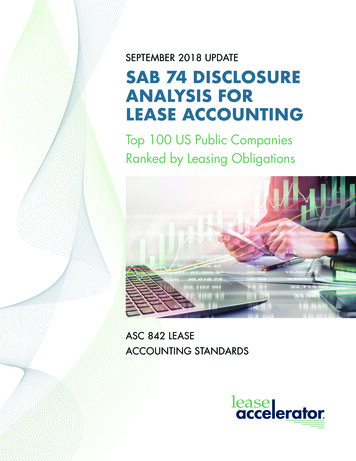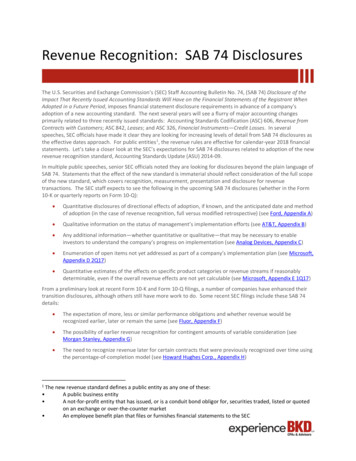
Transcription
Revenue Recognition: SAB 74 DisclosuresThe U.S. Securities and Exchange Commission’s (SEC) Staff Accounting Bulletin No. 74, (SAB 74) Disclosure of theImpact That Recently Issued Accounting Standards Will Have on the Financial Statements of the Registrant WhenAdopted in a Future Period, imposes financial statement disclosure requirements in advance of a company’sadoption of a new accounting standard. The next several years will see a flurry of major accounting changesprimarily related to three recently issued standards: Accounting Standards Codification (ASC) 606, Revenue fromContracts with Customers; ASC 842, Leases; and ASC 326, Financial Instruments—Credit Losses. In severalspeeches, SEC officials have made it clear they are looking for increasing levels of detail from SAB 74 disclosures asthe effective dates approach. For public entities 1, the revenue rules are effective for calendar-year 2018 financialstatements. Let’s take a closer look at the SEC’s expectations for SAB 74 disclosures related to adoption of the newrevenue recognition standard, Accounting Standards Update (ASU) 2014-09.In multiple public speeches, senior SEC officials noted they are looking for disclosures beyond the plain language ofSAB 74. Statements that the effect of the new standard is immaterial should reflect consideration of the full scopeof the new standard, which covers recognition, measurement, presentation and disclosure for revenuetransactions. The SEC staff expects to see the following in the upcoming SAB 74 disclosures (whether in the Form10-K or quarterly reports on Form 10-Q): Quantitative disclosures of directional effects of adoption, if known, and the anticipated date and methodof adoption (in the case of revenue recognition, full versus modified retrospective) (see Ford, Appendix A) Qualitative information on the status of management’s implementation efforts (see AT&T, Appendix B) Any additional information—whether quantitative or qualitative—that may be necessary to enableinvestors to understand the company’s progress on implementation (see Analog Devices, Appendix C) Enumeration of open items not yet addressed as part of a company’s implementation plan (see Microsoft,Appendix D 2Q17) Quantitative estimates of the effects on specific product categories or revenue streams if reasonablydeterminable, even if the overall revenue effects are not yet calculable (see Microsoft, Appendix E 1Q17)From a preliminary look at recent Form 10-K and Form 10-Q filings, a number of companies have enhanced theirtransition disclosures, although others still have more work to do. Some recent SEC filings include these SAB 74details:1 The expectation of more, less or similar performance obligations and whether revenue would berecognized earlier, later or remain the same (see Fluor, Appendix F) The possibility of earlier revenue recognition for contingent amounts of variable consideration (seeMorgan Stanley, Appendix G) The need to recognize revenue later for certain contracts that were previously recognized over time usingthe percentage-of-completion model (see Howard Hughes Corp., Appendix H)The new revenue standard defines a public entity as any one of these:A public business entityA not-for-profit entity that has issued, or is a conduit bond obligor for, securities traded, listed or quotedon an exchange or over-the-counter market An employee benefit plan that files or furnishes financial statements to the SEC
Revenue Recognition: SAB 74 DisclosuresThe SEC recognizes that SAB 74 disclosures are preliminary and subsequent changes in disclosed estimates will notbe assumed to reflect a control deficiency relating to prior disclosures. A company’s disclosures should evolveover time and be consistent with information provided to its audit committee and investors. As managementcompletes portions of its implementation plan and develops an assessment of the anticipated effect, effectiveinternal controls should be designed and implemented to timely identify disclosure content and ensure thatappropriately informative disclosure is made. The SEC announced it will pay close attention to both the accountingpolicy footnote addressing the effect of adoption of the new generally accepted accounting principles and acompany’s quarterly disclosures of any material changes to internal controls over financial reporting, given themagnitude of the implementation process.SEC officials emphasized that audit committees should be discussing the outside auditor’s views aboutmanagement’s implementation efforts. Wesley Bricker, SEC chief accountant, pointedly observed in his AmericanInstitute of CPAs keynote address: “Particularly for companies where implementation is lagging, preparers, theiraudit committees and auditors should discuss the reasons why [implementation is lagging] and provideinformative disclosures to investors about the status so that investors can assess the implications of theinformation. Successful implementation requires companies to allocate sufficient resources and develop orengage appropriate financial reporting competencies.”BKD continues to monitor the revenue recognition standard process. Visit BKD's Hot Topic page to learn more.ContributorAnne CoughlanDirector317.383.4000acoughlan@bkd.com2
Revenue Recognition: SAB 74 DisclosuresAppendix A – Ford Motor Company 2016 10-KWe will adopt the new revenue guidance effective January 1, 2017, by recognizing the cumulative effect of initiallyapplying the new standard as an increase to the opening balance of retained earnings. We expect this adjustmentto be less than 100 million, with an immaterial impact to our net income on an ongoing basis. Adoption of thenew standard will also result in changes in classification between Revenues, Cost of sales, Non-Financial Servicesinterest income and other income/(loss), net, and Financial Services other income/(loss), net.Appendix B – AT&T 2015 10-KUpon initial evaluation, we believe the key changes in the standard that impact our revenue recognition relate tothe allocation of contract revenues between various services and equipment, and the timing in which thoserevenues are recognized. We are still in the process of determining the impact on the timing of revenuerecognition and the allocation of revenue to products and segments.ASU 2014-09 also specifies that all incremental costs of obtaining and direct costs of fulfilling our contracts withcustomers should be deferred and recognized over the contract period or expected customer life. In the thirdquarter of 2015, we changed our accounting policy for the costs of fulfilling contracts with customers to defer allrecoverable costs while not changing our approach to acquisition costs. We believe, as a result of our accountingpolicy change for fulfillment costs, that the requirement to defer such costs in the new standard will not result in asignificant change to our results. The requirement to defer contract acquisition costs however, will result in therecognition of a deferred charge on our balance sheets, but as the industry continues to undergo changes in howdevices and services are sold to customers with impacts on the resulting commissions paid to our internal andexternal salesforces, we cannot currently estimate impact of this change.While we continue to evaluate the impact of the new standard and available adoption methods, we believe thestandard will require us to implement new revenue accounting systems and processes, which will significantlychange our internal controls over revenue recognition.Appendix C – Analog Devices 1Q17 10-QWe have developed a project plan for the implementation of the guidance including a review of all revenuestreams to identify any differences in the timing, measurement or presentation of revenue recognition. While theCompany is still in the process of completing its evaluation of the standard, it currently believes the mostsignificant impact will be related to the timing of recognition of sales to distributors. The Company currentlydefers revenue and the related cost of sales on shipments to distributors until the distributors resell the productsto their customers. Upon adoption of ASU 2014-09, the Company will no longer be permitted to defer revenueuntil sale by the distributor to the end customer, but rather, will be required to estimate the effects of returns andallowances provided to distributors and record revenue at the time of sale to the distributor. The Company iscontinuing to evaluate the future impact and method of adoption of ASU 2014-09 and related amendments on itsconsolidated financial statements and related disclosures. The Company is considering early adoption of the newstandard using the full retrospective method in the fiscal year ending November 3, 2018. The method of adoptionand the Company's ability to early adopt the standard is dependent on system readiness and the completion ofanalysis necessary to meet the requirements under ASU 2014-09.3
Revenue Recognition: SAB 74 DisclosuresAppendix D – Microsoft 2Q17 10-QWe currently anticipate early adoption of the new standard effective July 1, 2017. While our ability to early adoptusing the full retrospective method is dependent on system readiness, including software procured from thirdparty providers, and the completion of our analysis of information necessary to restate prior period financialstatements, we remain on schedule and have implemented key system functionality to enable restated financialinformation. Our progress includes nearing completion of retrospectively adjusted financial information for fiscalyear 2016.We anticipate this standard will have a material impact on our consolidated financial statements, and continue tomake progress in assessing all potential impacts of the standard, including any impacts from recently issuedamendments. We have reached conclusions on all key accounting assessments related to the new standard.However, we are still assessing impacts from guidance issued by the FASB Transition Resource Group as part oftheir November 2016 meeting. We will continue to monitor and assess the impact of changes to the standard andinterpretations as they become available. We have also started our assessment to determine the revenuerecognition impact of our recent acquisition of LinkedIn. The most significant impact of the standard relates to ouraccounting for software license revenue. Specifically, under the new standard we expect to recognize Windows 10revenue predominantly at the time of billing rather than ratably over the life of the related device. We expect torecognize license revenue at the time of contract execution rather than over the subscription period from certainmulti-year commercial software subscriptions that include both software licenses and Software Assurance. Due tothe complexity of certain of our commercial license subscription contracts, the actual revenue recognitiontreatment required under the standard will be dependent on contract-specific terms, and may vary in someinstances from recognition at the time of billing. We expect revenue recognition related to our hardware, cloudofferings including Office 365, and professional services to remain substantially unchanged.We continue to believe that the net change in Windows 10 revenue from period to period is indicative of the netchange in revenue we expect from the adoption of the new standard.Appendix E – Microsoft 1Q17 10-QWe currently anticipate adopting the standard using the full retrospective method to restate each prior reportingperiod presented. We currently anticipate early adoption of the new standard effective July 1, 2017. Our ability toearly adopt using the full retrospective method is dependent on system readiness, including software procuredfrom third-party providers, and the completion of our analysis of information necessary to restate prior periodfinancial statements.We anticipate this standard will have a material impact on our consolidated financial statements. While we arecontinuing to assess all potential impacts of the standard, we currently believe the most significant impact relatesto our accounting for software license revenue. We expect revenue related to hardware, cloud offerings, andprofessional services to remain substantially unchanged. Specifically, under the new standard we expect torecognize Windows 10 revenue predominantly at the time of billing rather than ratably over the life of the relateddevice. We also expect to recognize license revenue at the time of billing rather than over the subscription periodfrom certain multi-year commercial software subscriptions that include both software licenses and SoftwareAssurance. Due to the complexity of certain of our commercial license subscription contracts, the actual revenuerecognition treatment required under the standard will be dependent on contract-specific terms, and may vary insome instances from recognition at the time of billing.We currently believe that the net change in Windows 10 revenue from period to period is indicative of the netchange in revenue we expect from the adoption of the new standard.4
Revenue Recognition: SAB 74 DisclosuresAppendix F – Fluor 2016 10-KManagement is currently evaluating the impact of adopting ASU 2014-09, 2016-08, 2016-10, 2016-12 and 2016-20on the company's financial position, results of operations, cash flows and related disclosures. Adoption of theseASUs is expected to affect the manner in which the company determines the unit of account for its projects (i.e.,performance obligations). Under existing guidance, the company typically segments revenue and marginrecognition between the engineering and construction phases of its contracts. Upon adoption, the companyexpects that the entire engineering and construction contract will typically be a single unit of account (a singleperformance obligation), which will result in a more constant recognition of revenue and margin over the term ofthe contract. The company will adopt ASU 2014-09 during the first quarter of 2018. The company expects toadopt this new standard using the modified retrospective method that will result in a cumulative effect adjustmentas of the date of adoption.Appendix G – Morgan Stanley 2016 10-KWe will adopt the guidance on January 1, 2018 and are currently evaluating the method of adoption.We expect this accounting update to potentially change the timing and presentation of certain revenues, as well asthe timing and presentation of certain related costs, for Investment banking fees and Asset management,distribution and administration fees. Outside of Investment Management performance fees in the form of carriedinterest, these changes are not expected to be significant.Regarding the recognition of performance fees from fund management activities in the form of carried interestthat are subject to reversal, there are alternative views in the industry which include consideration as to whetherthese arrangements are in the scope of the new revenue guidance or are financial instruments under the scope ofequity method of accounting. If we follow the equity method of accounting principles, the current recognition ofsuch fees would remain essentially unchanged. If the fees are deemed in the scope of the new revenue guidance,we would defer recognition until such fees are no longer subject to reversal, which would cause a significant delayin the recognition of these fees as revenue. We are currently assessing the alternative accounting approaches andcontinue to closely monitor developments in this still-evolving area.We will continue to assess the impact of the new rule as we progress through the implementation of the newstandard; therefore, additional impacts may be identified prior to adoption.Appendix H – Howard Hughes Corporation 1Q17 10-QWe have concluded that after adoption we will not be able to recognize revenue for condominium projects on apercentage of completion basis, and generally revenue will be recognized when the units close and the title hastransferred to the buyer. We are continuing to evaluate the new guidance to determine any other impacts on ourconsolidated financial statements.5
SAB 74. Statements that the effect of the new standard is immaterial should reflect consideration of the full scope of the new standard, which covers recognition, measurement, presentation and disclosure for revenue transactions. The SEC staff expects to see the followin
